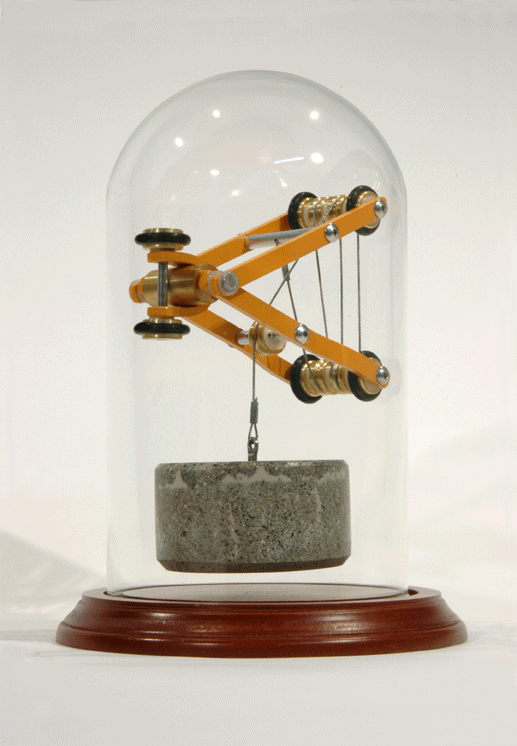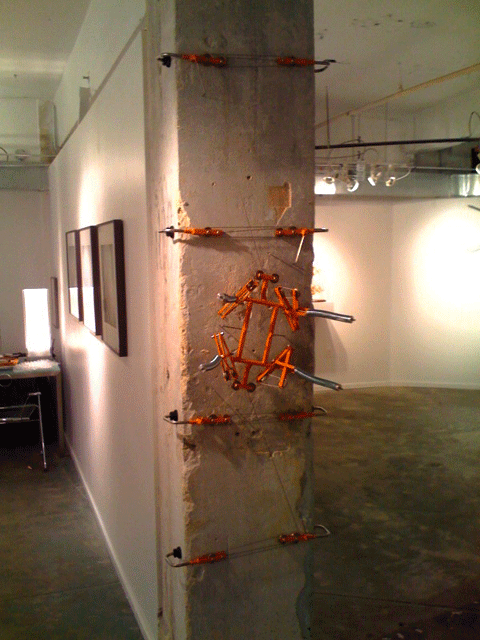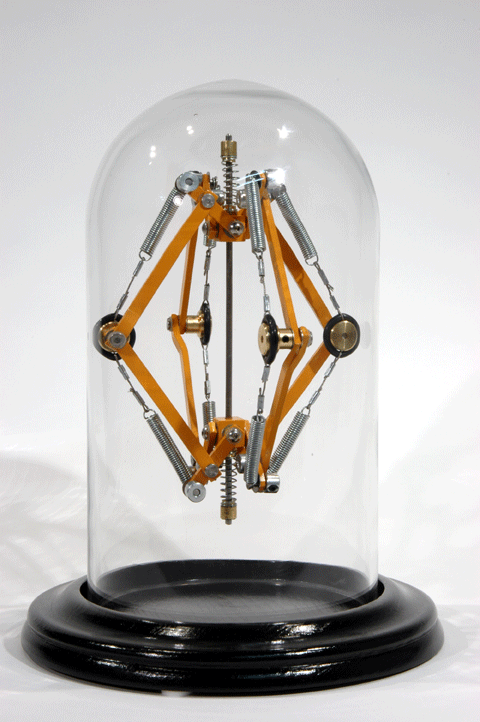 [Image: The spidery and self-supporting Cavity Mechanism #4 w/ Glass Dome by Dan Grayber, courtesy of Johansson Projects].
[Image: The spidery and self-supporting Cavity Mechanism #4 w/ Glass Dome by Dan Grayber, courtesy of Johansson Projects].
Artist Dan Grayber has a new show on display in Oakland, at Johansson Projects. It features an ingenious collection of spring-loaded devices that play on ideas of architecture, tension, mechanics, and space.
 [Image: Cavity Mechanism #2 w/ Glass Dome by Dan Grayber, courtesy of Johansson Projects].
[Image: Cavity Mechanism #2 w/ Glass Dome by Dan Grayber, courtesy of Johansson Projects].
They are more like booby traps—their only spatial purpose to support themselves in states of high tension—or re-tuned Vitruvian readymades sealed in glass.
 [Image: Cavity Mechanism #6 w/ Glass Dome by Dan Grayber, courtesy of Johansson Projects].
[Image: Cavity Mechanism #6 w/ Glass Dome by Dan Grayber, courtesy of Johansson Projects].
Grayber’s Cavity Mechanism #6 w/ Glass Dome, for instance, “is a pair of spring loaded mechanisms that wedge themselves into the inside of a cavity (the glass dome in this case), suspending themselves. Cable running between pair maintains tension on both mechanisms. If cable were to fail, both mechanisms would fall.”


 [Images: (top) Cavity Mechanism #5 w/ Glass Dome; (middle and bottom) Cavity Mechanism #3 w/ Glass Dome; all by Dan Grayber, courtesy of Johansson Projects].
[Images: (top) Cavity Mechanism #5 w/ Glass Dome; (middle and bottom) Cavity Mechanism #3 w/ Glass Dome; all by Dan Grayber, courtesy of Johansson Projects].
As the gallery describes his work, “Dan Grayber isolates machinery from its usual role of fulfilling human needs through placing it in an eternal mode of self-perpetuation. His safety-orange powder coated objects endlessly assure their survival through completing the simple and essential task of holding oneself up. These sculptures, which create problems as they solve them, exude a sovereign elegance, the dignity of not having to justify themselves to an outside source.”
 [Image: Untitled (fishbowl) Mechanism by Dan Grayber, courtesy of the artist].
[Image: Untitled (fishbowl) Mechanism by Dan Grayber, courtesy of the artist].
This notion of a “sovereignty” of the object is a compelling one: the aloof, isolated, self-supporting nature of these pieces is done away with utterly the instant they are pulled from their glass domes.
Forced out of what could be called the tautology of the dome—a precise space of limitations in which each mechanism can perform itself endlessly—these arachnid-like devices become functionally useless.
They become not sovereign at all, but parasites robbed of their original, enabling context.
 [Image: Column Mechanism #1 by Dan Grayber, courtesy of Johansson Projects].
[Image: Column Mechanism #1 by Dan Grayber, courtesy of Johansson Projects].
An example of Grayber’s experiments with this latter spatial condition is Column Mechanism #1.
Removed from the glass vitrine and installed directly on a concrete wall, it “consists of central tensioning mechanisms and eight ‘satellite’ contact objects, in pairs. Tension created from central mechanism is run through pulleys on each pair of ‘satellite’ objects, pulling them together, creating tension that squeezes column and supports central piece.”
Similarly, the “centrally located springs” of Drywall Mechanism #2 “use bicycle brake lines to carry tension of springs to the outer mechanisms. Outer mechanisms have points that when tensioned simultaneously gently dig into wall surface.”


 [Images: Drywall Mechanism #2 by Dan Grayber, courtesy of the artist].
[Images: Drywall Mechanism #2 by Dan Grayber, courtesy of the artist].
These latter examples also raise the intriguing possibility of a Dan Grayber installation disguised as everyday construction or architectural testing equipment: devices attached to drywall and concrete, like something straight out of a box from Home Depot. Until you notice the intricate systems of bike cables and tension lines, and the strangely functionless beauty of the forms poised just slightly on the right side of snapping…
 [Image: Cavity Mechanism #1 w/ Glass Dome by Dan Grayber, courtesy of the artist].
[Image: Cavity Mechanism #1 w/ Glass Dome by Dan Grayber, courtesy of the artist].
The gallery will be hosting an opening reception on February 4, in case you’re in Oakland and want to stop by; tell them you read about it on BLDGBLOG.

Those are beautiful. Thanks! I wish I could see them in person and figure out how they work.
Very well written article. I enjoyed this.
This kind of artwork is the kind that interests me most. I would love to know what the artist looks like
Brilliant work. I would love to see him create a "ship in a bottle" version of one of these mechanisms.
There is a "ship in a bottle" one. Just not on this site…
Reminds me of a small bridge over the river Don in Sheffield, which also passes through the arch of a larger, older bridge. Check out the Cobweb Bridge:
http://en.wikipedia.org/wiki/File:Spider_Bridge.jpg